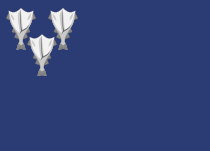Jørgen Jørgensen facts for kids
Quick facts for kids
Jørgen Jørgensen
|
|
|---|---|

Jørgen Jørgensen by Eckersberg
|
|
| Protector of Iceland | |
| In office 26 June 1809 – 22 August 1809 |
|
| Preceded by | Frederich Trampe as Governor of Iceland |
| Succeeded by | Frederich Trampe as Governor of Iceland |
| Personal details | |
| Born |
Jørgen Jürgensen
29 March 1780 Copenhagen, Denmark–Norway |
| Died | 20 January 1841 (aged 60) Hobart, Van Diemen's Land |
| Occupation | Mariner |
| Known for | Privateering Exploring Tasmania |
| Other names | The Dog-Days King |
Jørgen Jørgensen (born Jürgensen, later changed to Jorgenson) was a Danish adventurer. He was born on March 29, 1780, and died on January 20, 1841. He lived during a time of big changes in the world, known as the Age of Revolution.
In 1808, his ship was captured by the British Royal Navy. A year later, in 1809, he sailed to Iceland. There, he declared Iceland independent from Denmark. He even called himself the ruler of Iceland for a short time! He wanted to create a new republic, like the United States and French First Republic. Jørgensen also wrote many letters, articles, and pamphlets. He even worked with famous plant scientists like Joseph Banks. Many of his writings and drawings are kept in the British Library.
Contents
Early Life and Sea Adventures
Jørgen Jørgensen was the second son of a royal watchmaker. His older brother, Urban Jürgensen, was a very famous watchmaker. When Jørgen was 15, he finished school. He then started working on a British ship called the Janeon.
Voyages to Australia and New Zealand
In 1799, Jørgensen sailed to Cape Town in South Africa. From there, in 1800, he traveled to Port Jackson in Australia. This was a new British colony. He also visited New Zealand. In 1801, he joined the crew of the ship Lady Nelson.
As part of this crew, Jørgensen helped set up the first settlements in Van Diemen's Land. This place is now known as Tasmania. He was present when Risdon Cove and Sullivans Cove were founded. Many people consider him a founder of Hobart, which was then called Hobart Town. He is still seen as a local hero there.
After his time in Australia, he became a mate on a whaling ship called the Alexander. He sailed back to Britain on this ship, arriving in June 1806.
The King of Iceland
In 1807, Jørgensen was visiting his family in Denmark. He saw the Battle of Copenhagen. Soon after, he was given command of a small Danish ship, the Admiral Juul. In 1808, his ship fought a sea battle with a British ship, HMS Sappho. The British captured the Admiral Juul. They treated Jørgensen as a privateer, a ship captain allowed to attack enemy ships.
A Trip to Iceland
In 1809, while he was on parole (meaning he had promised not to fight), Jørgensen suggested a trip to Iceland. He knew the island was running out of food. This was because Denmark had a monopoly on trade with Iceland. Jørgensen went on a voyage with a ship called the Clarence. He went as an interpreter. However, this trip failed. The ship was British, and Britain was at war with Denmark-Norway.
Soon after, Jørgensen went on a second voyage to Iceland. When they arrived, the Danish-Norwegian Governor, Count of Trampe, still would not allow trading.
Becoming Protector
With the help of other crew members, Jørgensen arrested the governor. He then declared himself 'Protector' of Iceland. He promised to bring back the Althing, Iceland's ancient parliament. He wanted the Icelandic people to govern themselves. His goal was to create a free society, like those starting in the Americas and Europe at that time.
However, his rule did not last long. Two months later, the British ship HMS Talbot arrived. The Danish government was restored. Jørgensen was taken back to England. He was found guilty of breaking his parole. He was released in 1811.
Later Life and Return to Tasmania
Jørgensen spent the next few years in London. He faced financial difficulties which led to him spending time in prison. After being released in 1812, he traveled to Spain, Portugal, and Gibraltar. When he returned to England, he was again imprisoned due to his financial troubles.
Working for Intelligence
After writing to the British Foreign Office, Jørgensen was hired by the intelligence service. He translated documents and traveled through France and Germany. He worked as a spy as the Napoleonic Wars were ending. In 1815, Jørgensen was near the Battle of Waterloo. He was not directly involved in the fighting, but he saw some of the action.
After returning to England, Jørgensen continued to write many reports and articles. However, he faced serious legal problems in 1820. He was sent to Newgate Prison. Eventually, he was transported to Australia as a convict in 1825. He traveled on a ship called the Woodman.
Life in Tasmania
After five months at sea, Jørgensen arrived back in Tasmania in 1826. In 1827, he helped stop the use of fake money. Because of this, a group of local merchants asked the governor to grant him a ticket of leave. This allowed him more freedom.
Jørgensen led several explorations of Tasmania. He also worked for the Van Diemen's Land Council as a Constable. He was involved in efforts to manage relations with the local Aboriginal people. Jørgensen received a full pardon in 1835. He stayed in Tasmania. In 1831, he married an Irish convict named Norah Corbett. He died in the Colonial Hospital on January 20, 1841.
In Iceland, people call Jørgensen Jörundur hundadagakonungur. This means "Jørgen the Dog-Days King." It refers to the time when the dog star is visible in the sky.


